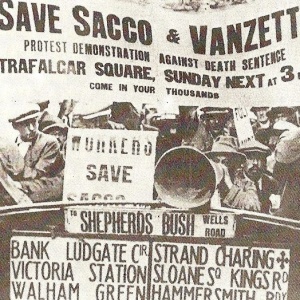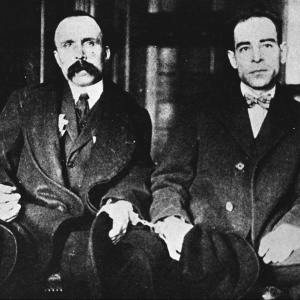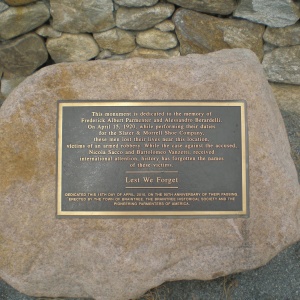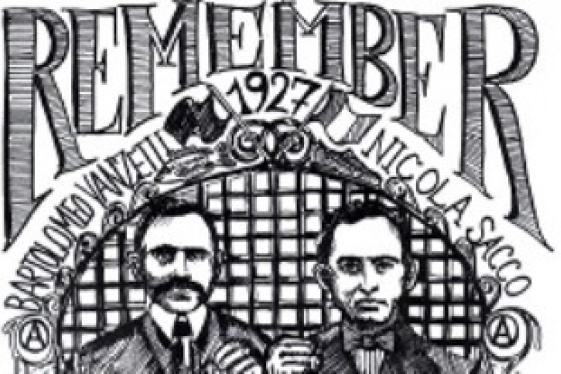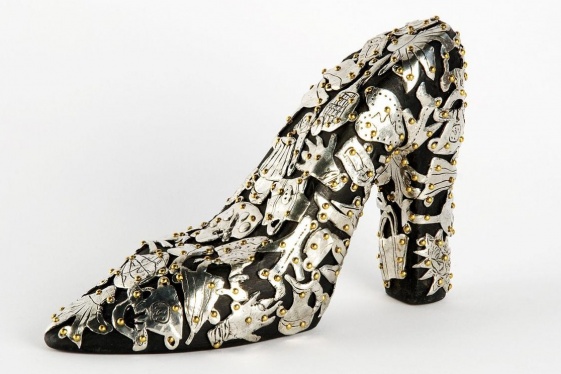
Mary Anne Trasciatti (Co-author of "Representing Sacco and Vanzetti")
Dopo 90 anni esattti dalla loro esecuzione, torniamo a parlare di Sacco e Vanzetti

The story of Sacco and Vanzetti is one of the most important and famous stories regarding the Italian American experience. Even in Italy, where unfortunately usually what happened to our fellow Italians who went to America seems not to bother much, these two Italians are well known, even if probably not many know exactly for what.
On August 23, 1927, Nicola Sacco and Bartolomeo Vanzetti were executed by electric chair. 90 years after, their story is still a mistery. We asked Mary Anne Trasciatti to tell our readers this painful, important Italian American story. Mary Anne is the co-author of the book "Representing Sacco and Vanzetti"
Mary Anne, for those who either don't know it or don't remember it exactly, could you please summarize to our readers who Sacco and Vanzetti were and why their story is so important?
Yes sure, Nicola Sacco and Bartolomeo Vanzetti were two Italian immigrants, who came here to United States and worked hard. Sacco was a very talented and skilled shoemaker, and Vanzetti, who was very smart, worked as an itinerant fish peddler travelling around and selling fish from a cart.
Although the two were not close friends at the time of their arrest, their names are now linked forever in history. Sacco was from Torremaggiore, in the province of Foggia, and Vanzetti was from Villafalletto, in Piedmont, so one was from the South and the other from the North; they really kind of represented the whole Italy. They were arrested in 1920, while they were living in Massachusetts. And this is the reason why we know about them; we would not know who they were and they would not be connected to one another if they weren't arrested together in 1920.
Allegedly, they robbed and murdered a paymaster and his guard at a shoe factory in South Braintree, Massachusetts, a little town just thirteen miles south of Boston. Their arrest happened during the first Red Scare - the diffusion of widespread fear of a potential rise of communism, anarchism, or radical leftism - in the United States. After World War I there was a real fear here in the US that what had happened in Russia – the Revolution – might happen here as well. Efforts had to be taken to make sure that it didn’t. The Red Scare started when a series of bombs were sent to government officials, including one in 1919 that was sent to the home of then-Attorney General, Alexander Mitchell Palmer. There was a glitch, however, and the bomb blew up the bomber himself. Evidence at the site that indicated the bombing was the work of Italian anarchists. So, the word went out, there were raids in various places, and Sacco and Vanzetti were swept up and arrested. They had done nothing wrong at the time of their arrest; they were in a streetcar in Brockton, Massachusetts, but they knew about the raids and when they were arrested they assumed it was for being radicals, anarchists. For that reason they didn’t protest their arrest. Unfortunately, their lack of protest was seen as proof by some that “they must be guilty!".
When they were taken by police, they really had no idea of what was going on. And there was very thin evidence connecting them to the crime in Braintree. People from the scene of the crime came forward as eye witnesses, but their testimony, their evidence was not very reliable because they were too far away to have seen anything with clarity. The evidence against Vanzetti was particularly weak and it was feared the case against him wouldn’t stick. To make the case for the Braintree crimes stronger, the prosecution essentially gave him a criminal record. He was tried for an earlier, unsolved crime, a robbery in Bridgewater, Massachusetts, and although he had an alibi (he was selling eels to his Italian customers for Christmas Eve dinner), the jury did not believe the witnesses who testified on his behalf, because they were Italian. Consequently, Vanzetti was found guilty. When he was brought on trial for the Braintree robbery-murder, he had a criminal record. This was important because although the prosecution lacked strong evidence against him for the Braintree crimes, the attorney could say “well, he is a convicted criminal.”
It is also important to note that Judge Webster Thayer presided over Vanzetti’s first trial. Thayer was then the judge who presided over the second trial of Vanzetti and Sacco for the Braintree robbery-murder. The second trial ended with their conviction in 1921. For the next several years a great effort was made on the part of their lawyers, especially Fred Moore, to get them a new trial. Moore filed five supplementary motions for a new trial, all of which were denied by JudgeThayer. Think about it: the same judge who presided over the conviction of Vanzetti in his first trial, and presided over the conviction of Sacco and Vanzetti in the second trial, decided on the appeals for a new trial. In order to have sided with the defendants, Judge Thayer would have had to have admitted, “I did something wrong during the Braintree trial,” and he just wasn't going to do that. He rejected all of the motions for a new trial, even though they were pretty serious motions. For example, one motion alleged perjury by witnesses for the prosecution. There was also a claim that police and federal authorities were colluding with each other. And there was a confession for the Braintree crime by a convicted bank robber named Celestino Madeiros, as well as evidence that the Braintree robbery-murder had actually been committed by a gang from Rhode Island, the Morelli Brothers. All these challenges were futile, however, and Sacco and Vanzetti were sentenced to death in 1926. They were electrocuted at just after midnight on August 23th, 1927.
So, there's a lot of drama in this story. People around the world tried to save Sacco and Vanzetti, including workers around the world, prominent attorneys here in the US and diplomats internationally, but the State of Massachusetts was pretty much deaf to the cries for justice. I think that it's an important story, for several reasons. First, it shows the flaws in our legal system, particularly in the State of Massachusetts, but not just there. I mean, the same judge provided over the first trial of Vanzetti, then the second trial of Sacco and Vanzetti, and then he declined all the supplementary motions. There should have been some way around Judge Thayer, but there weren’t. Also, the system was infected with political, and ethnic/racial discrimination. And these prejudices influenced justice: justice was not blind, the allegory of justice as a woman with scales who is blindfolded simply did not apply to this case. Certain kinds of people were less likely to be treated fairly in the system, because of their ethnicity or politics. And a final important thing about this story is that it shows the inhumanity of the death penalty: there was no indisputable evidence that Sacco and Vanzetti were guilty of the crimes for which they were tried, and yet they died for those crimes. The death penalty is a punishment that can’t be mitigated; once it is done, it is done. This case shows how inhumane the death penalty is.
Thinking about the Red Scare in the US, I don’t know about Italy at the time, but in the US the Red Scare was largely - not solely, but largely - directed against immigrants, Italians in particular, and that’s an important thing to keep in mind. During the trial and appeals process two laws passed in the US, one in 1921 and one in 1924, to restrict immigration. These laws were designed to return the profile of the immigrant to the US back to a Northern European one, to stem immigration from Southern and Eastern Europe, thus minimizing Italian, Greek, Slavic and Jewish immigration to return to what was considered the most desirable form of immigration, from Northern Europe. Passage of these laws happened while the Sacco-Vanzetti case was unfolding. This combination of things is important because it demonstrates the power of ethnic/racial prejudice, as well as political prejudice, against the two anarchists.
Why was anarchism very strong in that period, among the Italian community in the US?
Anarchism is the most radical ideology on the Left; it offers a seriously harsh critique of the state, particularly the capitalist state. Sacco and Vanzetti were not anarchists when they left Italy. They embraced anarchism as a response to the injustice and exploitation they saw around them in the US. When the two came here they found their countrymen and women living and working in horrible conditions, and this radicalized them. They themselves found low wages, really unhealthy and dangerous working conditions, long hours, and they saw that the political system wasn't addressing these injustices. People who tried to fight against exploitation were imprisoned; people who tried to organize workers were physically and verbally harassed and beaten. The mainstream politics of the US at that time did very little to address exploitative conditions. The most prominent American socialist of the time, Eugene Debs, was harshly critical of the system and of the war, and for that he was sent to prison.
Sacco and Vanzetti saw a political system that turned a blind eye to suffering and so they turned to anarchism. They felt that participating in the system was useless; voting was useless. To them, there was no point in voting: even if socialist candidates were elected they were prohibited from taking office.
Italians were well represented among anarchists. I think that an important reason why there was such disaffection from politics among many of them, was that they left a country where organizations that engaged in political dissent were brutally repressed by the state, rebellions were forcefully put down. When they came here and found an ideology that spoke to their concerns, but without much organization or structure, and they found it very appealing, and they went with it.
Was the discrimination against the Italians part of the motive for their unfair conviction?
I think that when you answer that question you always have to define discrimination. There were two forms of discrimination at work here, political and ethnic/racial. The people we’re talking about were of European races, here in the US we put most of the Europeans into the white category but in the 1920s, legally Italians were white, but they were treated and talked about as an inferior Mediterranean race, and consequently both forms of discrimination must be taken into consideration. They were discriminated both as Italians and as political dissenters.
Judge Webster said to a friend: “Did you see what I did with those anarchist bastards the other day? That ought to hold them!” He was really hard on these “anarchist bastards” in court. Although he didn’t much care for Italians, He didn’t say Italian bastards or Italians anarchist bastards, he said anarchist bastards. Because Sacco and Vanzetti were anarchists their loyalty to the US was questioned and this “disloyalty” was brought into the case. For example, it was noted that they had dodged the draft during World War I and gone to Mexico. But as Italians they were not eligible to serve in the US Army! In the 1920s, if you were a radical political dissenter, if you were not a patriot, it was easy for people to see you as a criminal. The logic was that there’s something wrong with anyone who questions the so-called American way.
Can we say that the story of Sacco and Vanzetti awakened for the first time among the Italian community in the US the need to be more united, something like a point of no return for their conscience?
I'm inclined to say no. I mean, Italians knew that prejudice against them was real. In the 1890s there was a lynching of eleven Italians in New Orleans who had been accused but then acquitted of killing the chief of police. In other words, Sacco and Vanzetti's case wasn’t the first one where "justice" was unfair to Italians, just because they happened to be Italian. Also, there were constant attempts in the US to limit migration from Italy. Italians were aware of that. What happened to Sacco and Vanzetti surely intensified the impulse to unite against discrimination, but again we need to be careful. What do we mean by “unite?” Different Italians had different ideas about what that meant.
If you were an Italian supporter of Mussolini in the 1920s, the case of Sacco and Vanzetti fell under the label "ethnic prejudice": in this vision no one should mess with us because we’re going to "resist to the Anglo-Saxonization of America" (this is an actual quote from an Italian language newspaper of that time), and we're going to demonstrate that we are just as good as so-called Anglo Saxon Americans.
But if you were on the Left, the Sacc0-Vanzetti case was a matter of political repression, an example of the need to unite not just as Italians but as workers who needed to push the government to serve the needs of ordinary people, not rich people. There’s evidence of this perspective too, in the Italian language press in the US. Left newspapers railed against political repression while the more right wing mainstream newspapers were selling the case as a form of ethnic repression. Basically, in that moment, if you were an Italian, whether Sacco and Vanzetti were victims of ethnic prejudice or political prejudice depended on how you looked at the case.
On August 23, 1977, the 50th anniversary of the executions, Massachusetts Governor Michael Dukakis proclaimed both in English and Italian that Sacco and Vanzetti had been unfairly tried and convicted and that "any disgrace should be forever removed from their names." Was that the end of this story?
Massachusetts had Italian American governors before Dukakis and it’s too bad that it wasn’t an Italian American governor who made this proclamation, although it’s good that Michael Dukakis did it. But no, the proclamation was not the end of the story. We’re still talking about Sacco and Vanzetti. The case rears its head sometimes like a kind of ghost we see back from the water, and there's a continuing debate whether they were innocent or not.
One school of thought is that Vanzetti was innocent, you could practically bet your life that he didn’t commit the robbery and murder in Braintree. Regarding the guilt or innocence of Sacco, there’s still a lingering doubt, there are some suggestions that he may have been guilty even though he wasn’t proven guilty without a shadow of a doubt. Truly, we don’t know. Did their attorney Fred Moore know something? Did someone else know something? We don’t really know. Some people believe that Vanzetti went to the electric chair knowing that he was innocent while Sacco was guilty. But we don’t know for sure.
Peter Miller’s documentary about the Sacco and Vanzetti case ends by linking the political climate of the 1920s to what was happening in the early 21st century in the US under George W. Bush, particularly discrimination against immigrants and political dissenters. With the election of Donald Trump, you could say that anti-immigrant hostilities are still an issue on the 90th anniversary!
Your commitment in remembering important events regarding fellow Italians emigrated in the United States doesn't stop at the Sacco and Vanzetti case. You are also the President of the Board of Directors of "The Remember the Triangle Fire Coalition". Please tell our readers a bit more about this event, and about the coalition
The Triangle Shirtwaist Factory Fire happened in New York in Greenwich Village in 1911, 146 people were killed when a fire burned a factory that made dresses and blouses for women. According to the testimony of some survivors of the fire doors where the girls were working had been locked because the factory owners wanted to keep the girls from stealing. The workers were mostly female and when the fire happened, over 60 workers jumped to their deaths. It was a terrible, horrible moment in New York City. A third of the people who died in the fire were Italians: the oldest was 43 years old, and the youngest was only 14 years old. They are now being memorialized in Italy. The "Triangle Fire Coalition" was founded in 2008 by artist Ruth Sergel. Ruth and the other members of the Coalition helped organize the ceremony for the 100th anniversary of the fire. I became chair of the group afterward. The Coalition includes a variety of people: artists, academics, union organizers, lawyers, community activists and others. It’s an inter-ethnic coalition of Italians and Jews and people of all kinds who spread the word about the fire and also about the good things that happened afterwards: The movement for workers’ rights in the US gained momentum, laws were passed ensure workplace safety and prohibit child labor. Here in the US we see the legacy of Triangle every day: fire escapes, maximum occupancy limits, outward opening doors. This was a tragedy but it also led to really good things.
Right now the Coalition is working to build a permanent memorial at the site of the fire. The building was fireproof and it still stands. It was the Asch Building, now it’s the Brown Building, and people come from all over the world come to see it. Triangle is a story about many things: migration, labor, and women, among others. Historically, here in the US, Italian American women did not have a recognized public presence. Although Italian and Italian American women are very strong people, there are still lingering stereotypes about us that we’re uneducated, that we make pasta on Sunday. So it is very important to tell the story of Italian immigrant women working, organizing, and really struggling to make a better life. My mom was a garment worker, and this shapes my connection to the fire: when I was growing up I remember she told me that she was safe in the factory where she worked because of the laws passed after what happened to the girls at Triangle.
You may be interested
-
9th Annual Sacco and Vanzetti March/Rally
Saturday, August 23rd, in Boston, the 87th anniversary of the execution of Nicola Sacco an...
-
Emanuele: cervello d'Italia al Mit di Boston
Si chiama Emanuele Ceccarelli lo studente del liceo Galvani di Bologna unico italiano amme...
-
Italian world language teacher 2015-2016
FRAMINGHAM PUBLIC SCHOOLS - JOB DESCRIPTION TITLE: World Language Teacher - Italian...
-
'A real Italian experience': Quincy's Italian...
Smoked prosciutto, Buffalo mozzarella, gorgonzola, mortadella, Zeppole di San Giuseppe. Al...
-
'Celebrating Italian heritage': Worcester's I...
Shrewsbury Street was transformed into little Italy Sunday afternoon as community members...
-
'Cello Bar
When life gave them lemons, the Pallini family didn't make lemonade — they made limoncello...
-
'Claudia DeMonte: A World View' Opens August...
Cape Cod Museum of Art will present an exhibition of provocative installations by artist...
-
'I took a shot.' After 35 years, North Truro...
Growing up in an Italian-American household, Robert Montano, chef-owner of Montano's Resta...







